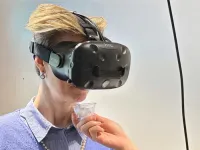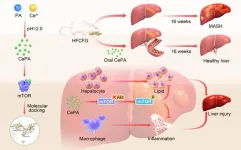(Press-News.org)
Overcoming Historical Barriers
Silicon, the cornerstone of modern electronics, photovoltaics, and photonics, has traditionally been limited to surface-level nanofabrication due to the challenges posed by existing lithographic techniques. Available methods either fail to penetrate the wafer surface without causing alterations or are limited by the micron-scale resolution of laser lithography within Si. In the spirit of Richard Feynman's famous dictum, 'There's plenty of room at the bottom', this breakthrough aligns with the vision of exploring and manipulating matter at the nanoscale. The innovative technique developed by the Bilkent team surpasses current limitations, enabling controlled fabrication of nanostructures buried deep inside silicon wafers with unprecedented control.
The team tackled the dual challenge of complex optical effects within the wafer and the inherent diffraction limit of the laser light. They overcome these by employing a special type of laser pulse, created by an approach called spatial light modulation. The non-diffracting nature of the beam overcomes optical scattering effects that have previously hindered precise energy deposition, inducing extremely small, localized voids inside the wafer. This process is followed by an emergent seeding effect, where preformed subsurface nano-voids establish strong field enhancement around their immediate neighborhood. This new fabrication regime marks an improvement by an order of magnitude over the state-of-the-art, achieving feature sizes down to 100 nm.
"Our approach is based on localizing the energy of the laser pulse within a semiconductor material to an extremely small volume, such that one can exploit emergent field enhancement effects analogous to those in plasmonics. This leads to sub-wavelength and multi-dimensional control directly inside the material", explained Prof. Tokel. "We can now fabricate nanophotonic elements buried in silicon, such as nanogratings with high diffraction efficiency and even spectral control."
The researchers used spatially-modulated laser pulses, technically corresponding to a Bessel function. The non-diffracting nature of this special laser beam, which is created with advanced holographic projection techniques, enables precise energy localization. This, in turn, leads to high temperature and pressure values enough to modify the material at a small volume. Remarkably, the resulting field enhancement, once established, sustains itself through a seeding type mechanism. Simply put, the creation of earlier nanostructures helps fabricate the later nanostructures. The use of laser polarization provides additional control over the alignment and symmetry of nanostructures, enabling the creation of diverse nano-arrays with high precision.
"By leveraging the anisotropic feedback mechanism found in the laser-material interaction system, we achieved polarization-controlled nanolithography in silicon," said Dr. Asgari Sabet, the study's first author. "This capability allows us to guide the alignment and symmetry of the nanostructures at the nanoscale."
The research team demonstrated large-area volumetric nanostructuring with beyond-diffraction-limit features, enabling proof-of-concept buried nano-photonic elements. These advances have significant implications for developing nano-scale systems with unique architectures. "We believe the emerging design freedom in arguably the most important technological material will find exciting applications in electronics and photonics", said Tokel. "The beyond-diffraction-limit features and multi-dimensional control imply future advances, such as metasurfaces, metamaterials, photonic crystals, numerous information processing applications, and even 3D integrated electronic-photonic systems."
"Our findings introduce a new fabrication paradigm for silicon," concluded Prof. Tokel, "The ability to fabricate at the nano-scale directly inside silicon opens up a new regime, toward further integration and advanced photonics. We can now start asking whether complete three-dimensional nano-fabrication in silicon is possible. Our study is the first step in that direction."
About the Researchers
The research team consists of Rana Asgari Sabet, Aqiq Ishraq, Alperen Saltik, Mehmet Bütün, and Onur Tokel, all affiliated with the Department of Physics and the National Nanotechnology Research Center at Bilkent University. Their expertise spans various fields, including optics, materials science, and nanotechnology.
Publication and Availability
The full details of this research are published in the latest issue of Nature Communications. The article, titled "Laser nanofabrication inside silicon with spatial beam modulation and anisotropic seeding," is available here : https://www.nature.com/articles/s41467-024-49303-z
Funding: This study is supported by The Scientific and Technological Research Council of Türkiye (TUBITAK) and the Turkish Academy of Sciences.
END
Preeclampsia (PE) is a significant contributor to the increase in maternal morbidity and mortality worldwide, with particularly alarming numbers in the United States, where it affects about 2–8% of pregnancies, resulting in premature birth with associated morbidities for their infants as well. A new study by researchers at UCLA Health finds that early detection of specific microRNAs (miRNAs) packaged in vesicles may offer the opportunity to predict preeclampsia in pregnant people before clinical symptoms manifest.
The study, led by Dr. Sherin U. Devaskar, MD, executive chair of the Department of Pediatrics ...
Researchers from the Qingdao Institute of Bioenergy and Bioprocess Technology (QIBEBT) of the Chinese Academy of Sciences have developed low-cost micro-sized silicon anodes from recycled photovoltaic waste using a novel electrolyte design.
Their pioneering work, published in Nature Sustainability on July 16, offers a path to more sustainable, low-cost, and high-energy-density batteries that could transform energy storage systems for electric vehicles and renewable energy applications.
Silicon anodes are favored for their ability to substantially increase the energy density of lithium-ion batteries compared to traditional graphite anodes but are hindered by significant volume ...
Billions of dollars in foreign aid could be spent more effectively if international poverty statistics were more accurate, according to new research led by King's College London.
Dr Michail Moatsos, a research fellow in the Department of International Development, says current methods for calculating the international poverty line lead to a skewed picture of how poverty is distributed across the world – and this is hampering attempts to eradicate it.
“Currently, international donors cannot prioritise their funds based on the best possible information and therefore funnel those funds to those most in need around the world. A $2.15 per day poverty line affords very different ...
Scientists from RMIT University have led a world-first study on common food aromas that may help explain why astronauts report that meals taste bland in space and struggle to eat their normal nutritional intake.
This research, which is published in the International Journal of Food Science and Technology, has broader implications for improving the diets of isolated people, including nursing home residents, by personalising aromas to enhance the flavour of their food.
Previous research has shown that aroma plays a big role in the flavour of food.
The team in this study tested how people perceived vanilla and almond extracts and lemon essential oil changed from normal environments on ...
Britain, prepare for deep depression: storms ruin tea.
A new study reveals that Storm Ciaran cut an invisible path of mayhem across southern Britain last autumn, destroying any possibility that 20 million people could have a proper cup of tea at breakfast.
The storm's record-breaking low pressure meant the boiling point of water was below the crucial 100 degrees Celsius required for a decent cuppa, meteorologists at the University of Reading have discovered.
In a study published today [Tuesday, 16 July] in the journal Weather, the scientists reported that water in Reading was boiling at just 98°C.
During the storm on the morning of November 2, ...
With the rapid development of AI technology, voice-controlled smart speakers are becoming increasingly popular due to their convenience and ability to control compatible home devices. Despite the rise in use, smart speakers often do not have screens and little-to-none of the visual information feedback common to manually operated devices. This aspect complicates their usability, thus providing room for research and subsequent improvement.
As such, a research team led by Dr. Toshihisa Doi, a lecturer at Osaka Metropolitan University’s Graduate School of Human Life and Ecology, recruited 39 young adults (22 males and ...
Metabolic dysfunction-associated steatohepatitis (MASH) is one of the most common chronic liver diseases, primarily caused by metabolic disorders and systemic inflammatory responses. Although the incidence of MASH is gradually increasing, there is a lack of effective drugs and methods for its treatment, thus limiting therapeutic options for MASH. Professor Liu Lei's team has long focused on the treatment and molecular mechanisms of liver-related diseases. Due to cerium's significant antioxidant and anti-inflammatory activities, as well as its hepatophilicity and good biosafety, it shows great potential ...
Krishna Reddy, MD, MS, a physician-investigator at the Medical Practice Evaluation Center and the Tobacco Research and Treatment Center at Massachusetts General Hospital and an Associate Professor of Medicine at Harvard Medical School, is the senior author of a recently published paper in Journal of the International AIDS Society: Tobacco Smoking, Smoking Cessation and Life Expectancy Among People with HIV on Antiretroviral Therapy in South Africa: A Simulation Modelling Study.
What Question Were You Investigating in this Study?
Now that more people with HIV in South Africa are on antiretroviral therapy (medicines to treat ...
If a man and a woman each suffer a heart attack, you may assume the symptoms and diagnoses should be the same.
That’s not always the case. While men are more likely to show the more “typical” signs of a heart attack — chest pains, shortness of breath — women are more likely to experience pain in their necks or symptoms that feel like heartburn or nausea. An angiogram that shows a blockage in male blood vessels may not show occlusion in a woman’s smaller vessels, and these differences can lead ...
Investigators at the UCLA Health Jonsson Comprehensive Cancer Center have uncovered new details about the role of a protein called interferon regulatory factor (IRF1) in cancer progression and treatment response, offering new insight that can potentially help improve the effectiveness of cancer immunotherapy.
The study, published in Cell Reports, reveals how IRF1 can both hinder and help the body's immune response to tumors, depending upon which cells the protein is found in.
“We know IRF1 plays ...


